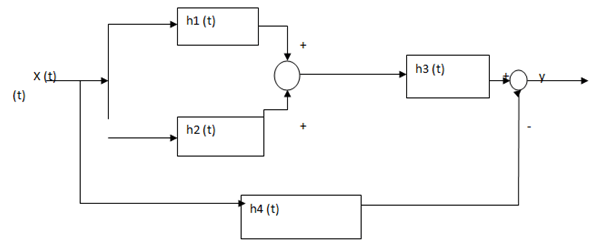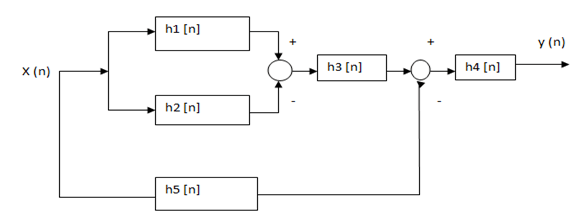This set of Signals & Systems Questions and Answers for Aptitude test focuses on “Properties of the Impulse Response Representation for LTI Systems”.
1. If two LTI systems with impulse response h1 (t) and h2 (t) and are connected in parallel then output is given by ______
a) y(t) = x(t) *(h1(t) + h2(t))
b) y(t) = x(t) + (h1(t) + h2(t))
c) y(t) = x(t) * (h1(t) h2(t))
d) y(t) = (x(t) * h1(t)) + h2(t)
View Answer
Explanation: The equivalent impulse response of two systems connected in parallel is the sum of individual impulse responses. It is represented as
y(t) = x(t) * h1(t) + x(t) * h2(t) = x(t) * (h1(t) + h2(t)).
2. When two LTI systems with impulse responses ha (t) and hb (t) are cascaded then equivalent response is given by ______
a) h(t) = ha(t) + hb(t)
b) h(t) = ha(t) – hb(t)
c) h(t) = ha(t) hb(t)
d) h(t) = ha(t) * hb(t)
View Answer
Explanation: The equivalent impulse response of two systems connected in series (cascaded) is given by convolution of individual impulse responses.
3. What is this property of impulse response is called ___________
h1(t) * h2(t) = h2(t) * h1(t)
a) Associative property
b) Commutative property
c) Distributive property
d) Closure law
View Answer
Explanation: Impulse response exhibits commutative property and it is given mathematically by the equation
h1(t) * h2(t) = h2(t) * h1(t).
4. The overall impulse response of the system is given by ______

a) h(t) = (h1(t) + h2(t) * h3(t)) – h4(t)
b) y(t) = x(t) * (h1(t) + h2(t)*h3(t)) – h4(t)
c) h(t) = (h1(t) + h2(t) * h3(t)) + h4(t) * x(t)
d) h(t) = (h1(t) h2(t) * h3(t)) – h4(t)
View Answer
Explanation: In the above given system h1 (t) and h2 (t) are connected in parallel hence it is
h1 (t) +h2 (t) which is cascaded to h3 (t) and its equivalent is connected in parallel with h4 (t). Hence the equivalent impulse response is given by h(t) = (h1(t) + h2(t) * h3(t)) – h4(t).
5. The overall impulse response of the system is given by ______

a) h[n] = (h1[n]-h2[n])*h3[n]+h5[n]*h4[n]
b) h[n] = (((h1[n]-h2[n])*h3[n])+h5[n])*h4[n]
c) h[n] = (((h1[n]-h2[n])*h3[n])-h5[n])*h4[n]
d) h[n] = (((h1[n]-h2[n])*-h3[n])-h5[n])*h4[n]
View Answer
Explanation: Here in the above system h1 [n] and h2 [n] are connected in parallel and given by h1 [n] – h2 [n], this is cascaded with h3 [n] and given by (h1 [n] – h2 [n]) * h3 [n], this is again connected in parallel with h5 [n] and its equivalent is cascaded with h4 [n]. The equivalent response is given by h[n] = (((h1[n]-h2[n])*h3[n])-h5[n])*h4[n].
6. The condition for memory-less system is given by _____
a) h[k] = cδ[k]
b) h[k] = cδ[n-k]
c) h[k] = ch[k]δ[k]
d) h[k] = ch[n-k]δ[k]
View Answer
Explanation: The LTI discrete-time system is said to be memory-less if and only if it satisfies the condition h[k]=cδ[k]. All memory-less LTI systems perform scalar multiplication on the input.
7. The causal continuous system with impulse response should satisfy ____ equation.
a) h(t)=0,t<0
b) h(t)=0,t>0
c) h(t)≠0,t<0
d) h(t)≠0,t≤0
View Answer
Explanation: To the continuous system to be causal, the impulse response should satisfy the equation h(t)=0,t<0 and convolution integral is given by y(t)=∫0∞ h(τ)x(t-τ)dτ.
8. Causal systems are ______
a) Anticipative
b) Non anticipative
c) For certain cases anticipative
d) For certain cases anticipative and non anticipative
View Answer
Explanation: Causal systems are non anticipative. They cannot generate an output before the input is applied. Which indicates the impulse response is zero for negative time.
9. Which of the following is true for discrete-time stable systems?
a) \(∑_{k=-∞}^∞\) |h[k]| < ∞
b) \(∑_{k=0}^∞\) |h[k]|< ∞
c) \(∑_{k=-∞}^∞\) |h[k]| ≤ ∞
d) \(∑_{k=-∞}^0\) |h[k]|< ∞
View Answer
Explanation: If the condition ∑∞k=-∞|h[k]|<∞ is satisfied by an LTI system then it is said to be stable and for continuous time signal the condition is given by integral
∫∞-∞ |h(τ)|dτ<∞.
10. The impulse response of discrete-time signal is given by h [n] = u [n+3]. Whether the system is causal or not?
a) Causal
b) Non-causal
c) Insufficient information
d) The system cannot be classified
View Answer
Explanation: The given impulse response h [n] = u [n+3] is not causal because of the term u [n+3] which implies it is non zero for n= -1, -2, -3.
Sanfoundry Global Education & Learning Series – Signals & Systems.
To practice all areas of Signals & Systems for Aptitude test, here is complete set of 1000+ Multiple Choice Questions and Answers.
If you find a mistake in question / option / answer, kindly take a screenshot and email to [email protected]
